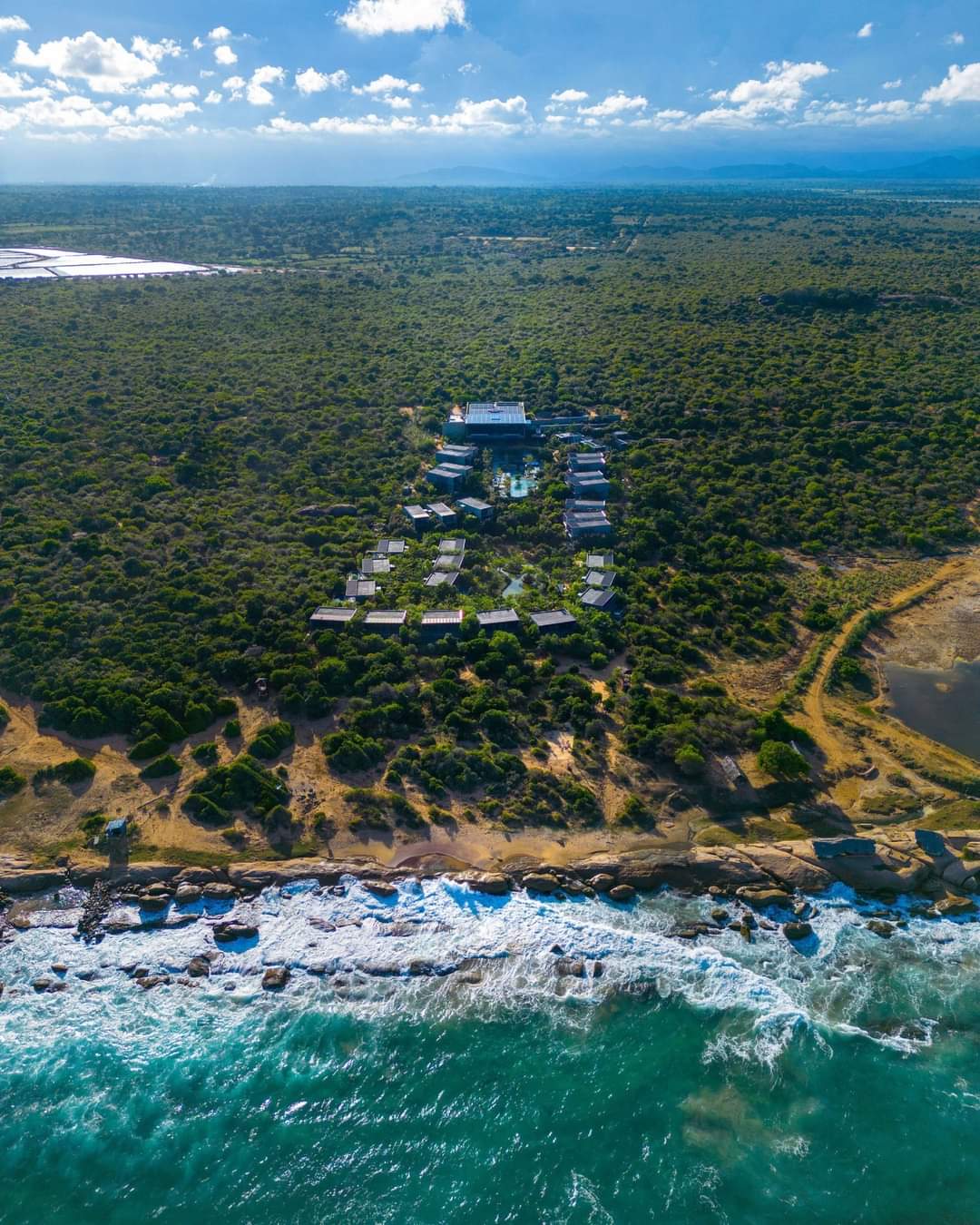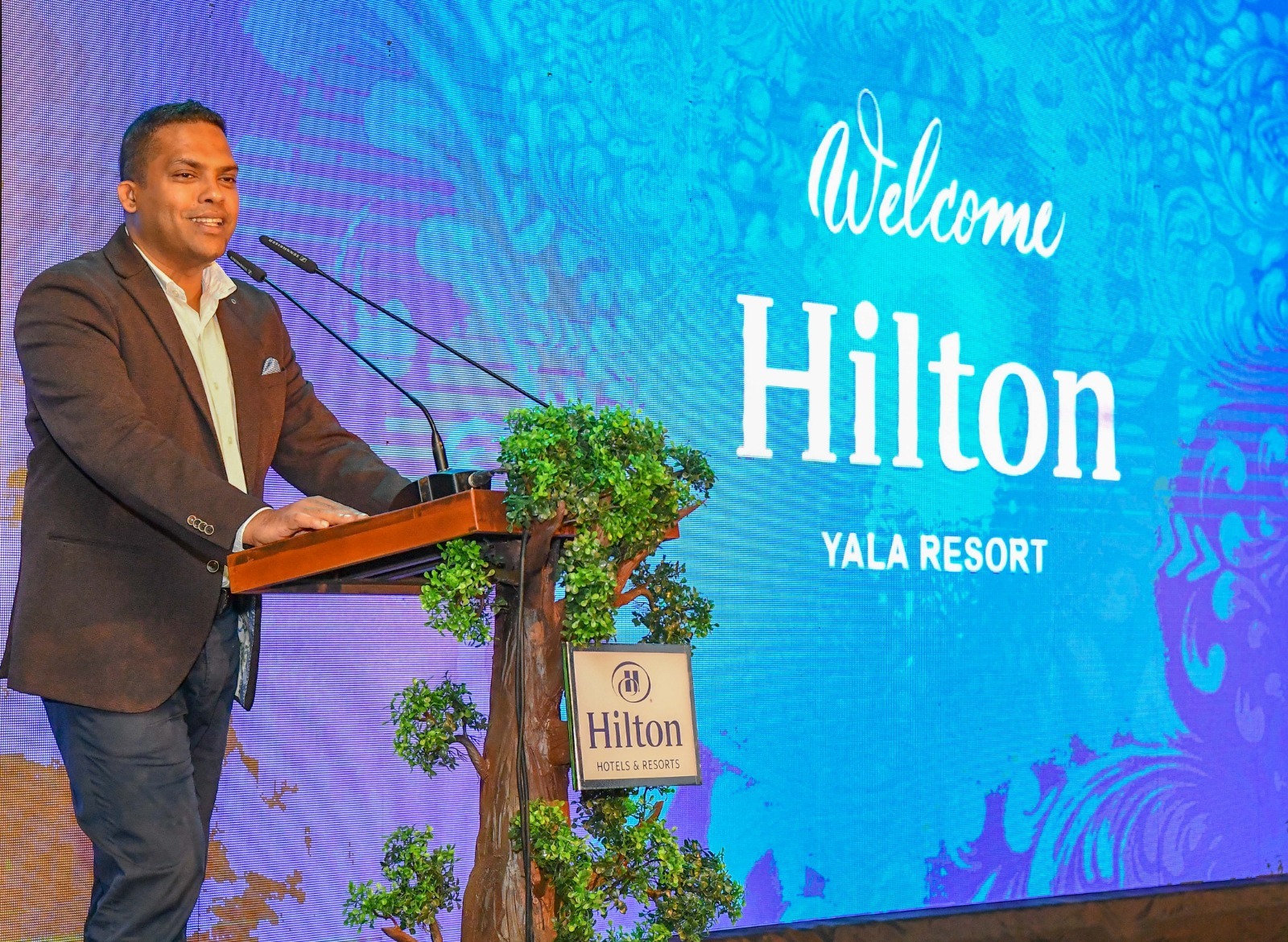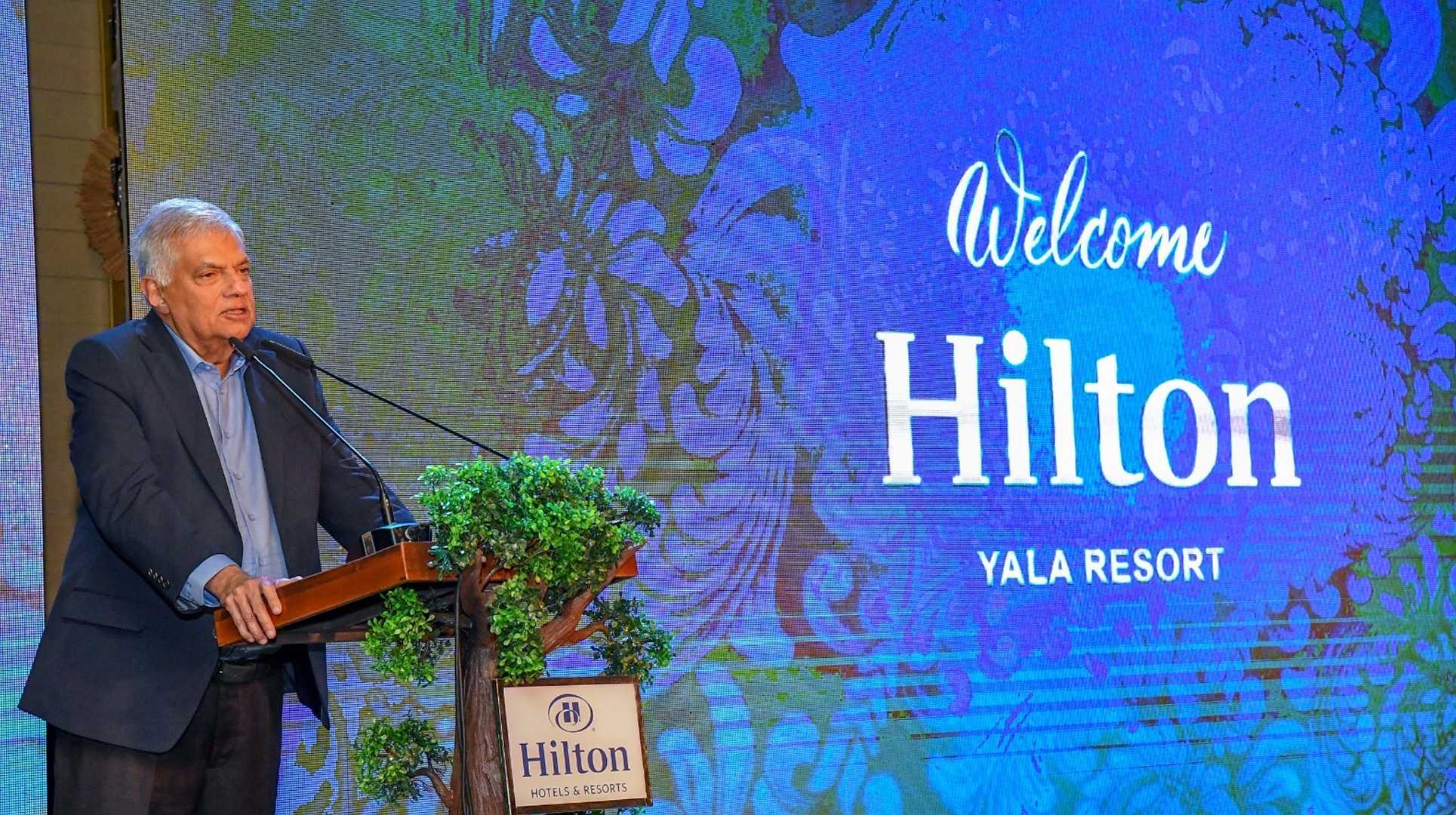President Ranil Wickremesinghe highlighted that the tourism industry stands as the paramount sector capable of swiftly advancing the country’s economic objectives. The government, under his leadership, has implemented numerous pivotal measures to foster its growth.
The President emphasized the significance of substantial contributions from both the public and private sectors. He stressed that the government is diligently working to provide necessary amenities for all stakeholders involved.
Addressing the audience at the inauguration of the Hilton Yala Resort, a luxurious establishment within the Hilton Hotel Group, President Ranil Wickremesinghe underscored the urgent need for comprehensive development in the region. The Yala National Park, frequented by local and international tourists daily, was singled out as a key area for such development.
Minister of Tourism and Lands, Mr. Harin Fernando, speaking at the event, commended President Ranil Wickremesinghe’s new initiatives to bolster the tourism industry. He expressed optimism that these efforts could position tourism as a primary revenue source for the country.
President Ranil Wickremesinghe, adding his thoughts, expressed his satisfaction in inaugurating the upscale Hilton hotel in the Yala region. He noted that this move would attract energetic tourists and invigorate the tourism sector. He extended gratitude to Melwa and the Hilton Group for their contributions.
Recalling the historical significance of the area, President Ranil Wickremesinghe alluded to the ancient shrines of Situlpawwa and Akasha Chaitya that once graced the Yala region. He praised the past fertility and collaboration that defined the area, as well as its remarkable architectural marvels.
The President emphasized a resolute commitment to advancing the tourism industry, urging collective participation towards this goal. He envisioned the development of the Yala area as a unified tourist destination, incorporating nearby regions like Udawalawe. This interconnected approach, he suggested, would drive progress and further enhance the tourism experience in the region.


“Furthermore, there is a pressing need to enhance the facilities catering to tourists visiting these regions. I kindly urge both the Minister of Wildlife and Forest Conservation and the Minister of Tourism, along with their respective ministry officials, to collaborate on devising a comprehensive development plan for the Yala area. This expansion should extend to encompass locales like Galoya, Maduruoya, Somavatiya, Minneriya, and Wasgamuwa.
The industry has to be involved, and that is a prerequisite. I have been also looking at this hotel and the area, and I thought we should also promote Yala. We will introduce the greater Yala.
Why are you going to call these places Udawalawe, Kumana and all? These are all connected, and the elephant path passage from Udawalawe will take you up to Kumana. So, let’s brand this as Greater Yala and make it Greater Yala for all promotional activities.
So, why only have luxury hotels here? You can have some near, I am sure, just outside Kumana before Arugambe, we can find some land for another set. Somewhere in Udawalawe, somewhere in Lunugamwehera, where those who want to can also access the Kataragama shrines.
So, these are places. Why don’t we develop them? I am asking the Minister, together with the Minister of Wildlife and Conservation, as well as the officials of those two ministries, to come up with the Greater Yala concept. I don’t think we should stop there. If you take Galloya, Maduroya, Somavathiya, Minneriya, and Wasgamuwa, you will have a unique brand. So, just have two brands and Wilpattu, which can stand on its own. And certainly, why don’t you get into a yacht in Colombo, come to Puttlam Bay, spend a day or two at Wilpattu and get back? So, you will have some wildlife reserves, which will be different from what you can get in other places.
Additionally, an intriguing prospect lies in establishing wildlife reserves that offer visitors a fresh and unique experience, reminiscent of the offerings in countries like India and Nepal. This avenue warrants significant attention as we formulate a new strategy to elevate the tourism industry.
It is essential that we set ambitious targets for the tourism sector, with the goal of doubling the influx of tourists to our country.
Correspondingly, the revenue generated from tourism should witness a four to fivefold increase.
Reflecting on my visit to the Maldives in 1981, I recall that their tourist income amounted to $25. Interestingly, at that time, fewer tourists visited the Maldives compared to our nation. Today, the number of tourists arriving here, approximately 2.5 million, equals the visitors to the Maldives.
Presently, we charge around $200 per tourist, while the Maldives charges approximately $700. Therefore, to invigorate the tourism industry, we must not only boost the number of tourists but also consider elevating the pricing.
Upon assuming the presidency, my responsibility extended beyond liberating the country from debt burdens. I was tasked with devising innovative avenues to generate income. Unlike industries and agriculture, which require time to yield returns, the tourism sector presents an avenue for swift contributions.
Hence, our primary objective revolves around promoting tourism to generate income and fulfil the needs of our people. As the year concludes, our hotels will brim with tourists—a trend that’s already underway. Looking ahead to the following year, we must not only fill our rooms with tourists but also double the resultant income.
Tourist accommodations across the nation are experiencing high occupancy rates in September, buoyed by the historic Dalada Perehara and the Asian Cup cricket tournament in Kandy. The upcoming Christmas season is anticipated to draw several internationally renowned artists and musicians, including the distinguished Western musician Andrey Mucher, slated to grace our shores in January.
The country hosts a myriad of events, such as the Galle Literary Festival, strategically designed to attract more visitors and generate vital revenue for the nation. Simultaneously, this endeavour should serve as a means of both income and employment, necessitating comprehensive training for the youth. In certain instances, this avenue has evolved into a gateway to international employment, highlighting the importance of collective engagement in shaping both individual futures and broader initiatives.
Numerous innovative proposals have been introduced to expedite the progress of our tourism sector. Notably, the government is working to extend support for individuals willing to allocate two rooms in their homes for tourists, providing excellent guest services while commanding rates upwards of a hundred dollars.
The imperative of achieving our tourism industry’s objectives is paramount. We aim to harness resources to swiftly generate income and employment prospects. In this pursuit, I appeal for the unwavering support of all individuals.”

Harin Fernando Minister of Tourism and Lands
“Under the guidance of the President, we have executed a range of initiatives aimed at boosting tourism. The outcomes are evident, with an increased inflow of tourists, particularly following the President’s visit to India. Notably, India constitutes the largest source of visitors to our country, followed by China. Air travel to Sri Lanka has surged, with airlines like Qatar Airways now operating up to six daily flights.
Sri Lanka has become an attractive destination for airlines, evidenced by the operation of flights by Turkish Airlines and Singapore Airlines seven days a week. Akira Airlines from Israel plans to launch direct flights to Sri Lanka twice a week, beginning October 31. Moreover, more flight additions are on the horizon. Our domestic airlines also contribute significantly, with around 80 flights to India weekly.
I extend my gratitude to all who have united to confront these challenges. It’s especially heartening to learn that the Hilton Hotel Group intends to inaugurate luxurious new hotels in Nuwara Eliya and Negombo. These endeavours are poised to make substantial contributions to our nation’s tourism industry.
The President’s novel approach to tourism promotion is a departure from past practices and has the potential to align with current industry goals. Statistics reveal that 31% of our tourists are repeat visitors. Our nation needn’t be confined to a particular tourist hotspot; instead, our identity should centre on warmth and hospitality. Foreign investors are increasingly drawn to Sri Lanka due to its welcoming atmosphere. It is crucial to sustain this warmth and hospitality to ensure the country’s continued allure.
I am confident that under the President’s visionary program, the tourism sector in our nation will experience resounding success, positioning it as the primary revenue generator.”
In attendance at this significant event were Professor Maithri Wickramasinghe, American Ambassador to Sri Lanka Mrs. Julie Chung, Secretary of the Ministry of Tourism and Lands H.M.B.P. Herath, Chairman of the Tourism Promotion Bureau Chalaka Gajabahu, Chairman of Sri Lanka Tourism and Hotel Management Institute Mr. Shirantha Peiris, as well as other distinguished personalities.
Meanwhile, President Ranil Wickremesinghe embarked on an inspection tour of the Yala National Park. During the visit, he highlighted the option of purchasing park tickets online for both local and foreign visitors. Acknowledging the arid climate, the President also observed efforts to rejuvenate dried-up water ponds within the park. Accompanying him were Minister Harin Fernando and American Ambassador to Sri Lanka Mrs. Julie Chung.
Also present to grace the occasion were Jamie Mead, Senior Operations Director (South East Asia) of the Hilton Hotels Group, Josh Roberts, Senior Operations Director (Asia & Australasia), Sri Lanka Hilton Hotels Group Regional General Manager Manesh Fernando, Hilton Yala Resort General Manager Gitanjali Chakravarthy, Mr. Muruga Pillai, Director of Melwa Hotels & Resorts Private Limited, and several other esteemed officials











